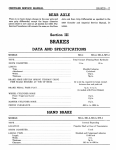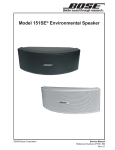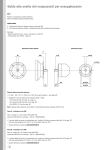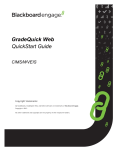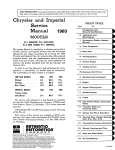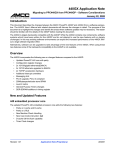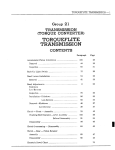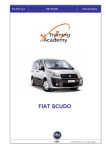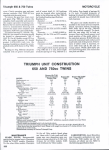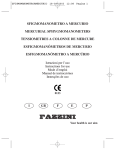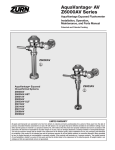Download Section XI TORQUEFLITE TRANSMISSION
Transcript
80—TRANSMISSION CHRYSLER SERVICE MANUAL Install the new " 0 " ring in the ferrule groove. Lubricate the small bore of the column jacket support (for cylinder head ferrule). Install the jacket support assembly over the worm shaft carefully engaging the cylinder head ferrule and " 0 " ring, making sure the reaction rings enter the groove in the jacket support assembly. Align the parts on power train so the valve lever hole in the center bearing spacer is 90° counterclockwise from the piston rack teeth and lock all parts to the worm shaft by entering a suitable drift through the jacket support and worm shaft groove. Continue with Operation 18 — Reassembly of the Steering Gear as described in the Steering Section of the 1958 Chrysler and Imperial Service Manual, D-16350. Section XI TORQUEFLITE TRANSMISSION The servicing of the 1959 TorqueFlite Transmission is the same as that of the 1958 Models as described in the 1958 Chrysler and Imperial Service Manual, with the following exceptions. FRONT CLUTCH (8-LEVER) DISASSEMBLY (REFER TO FIG. 115) Remove the input shaft fiber thrust washer (A). Remove snap ring (B). Remove input shaft (C) from retainer (R). Invert retainer (R), remove driving discs (D), plates (E), pressure plate (F) and hub (G). Install spring compressor, Tool C-3533 and compress spring retainer (I). Using pliers, Tool C-3301, remove spring retainer snap ring (H). After removing compressor, Tool C-3533, remove spring retainer (I), spring (J), levers (L), lever retainer (K), cushion spring washer (M), and cush- ion spring (N) from retainer (R). With a twisting motion, remove piston (Q) from retainer (R). Inspection (Fig. 115) The inspection procedure is the same as for the 1958 model transmissions. Assembly (Fig. 115) Lubricate and install inner (rubber) seal ring (T) on hub of retainer (R). Make sure lip of seal is facing rear of retainer and seal is seated in groove. Lubricate and install outer seal ring (S) on piston (Q) with lip of seal towards rear of piston. Place piston assembly in retainer (R) using a twisting motion to seat piston in bottom of retainer. Install cushion spring (N) with dished side (concave) facing piston (Q). (Fig. 116). Place washer (M) with chamfer towards front of .020"-.040" INSTALL WASHER WITH CHAMFER ON THIS SIDE Fig. 115 — Front Clutch Assembly 1. 2. 3. 4. 5. 6. 7. 8. 9. 10. Thrust Washer Snap Ring—Large Input Shaft Driving Discs Clutch Plates Pressure Plate Driving Disc Hub Snap Ring-Small Piston Return Spring Retainer Piston Return Spring 11. 12. 13. 14. 15. 16. 17. 18. 19. 20. Piston Lever Retainer Piston Lever (8) Cushion Spring Washer Cushion Spring Oil Seal Ring-Small Oil Seal Ring-Large Piston Piston Retainer Piston Seal Ring-Large Piston Seal Ring—Small Fig. 116 —Installing Cushion Spring TRANSMISSION—81 CHRYSLER SERVICE MANUAL retainer (R). Place lever retainer (K) over hub of piston and install levers (L), as shown in Figures 116 and 117. Install return spring (J) over hub of retainer (R) and position spring retainer (I) and snap ring (H) on spring (J). Using compressor, Tool C-3533, compress return spring (J) sufficiently to seat snap ring (H) with pliers, Tool C-3301. Remove compressor tool. Install pressure plate (F) (smooth side up) in retainer (R). Install discs (D) and plates (E) by first placing one of the discs (D) in retainer (R) followed by a steel plate (E). Repeat this procedure until all discs and plates have been installed. CHECKING CLUTCH CLEARANCE Clutch clearance can be measured as described in the 1958 Chrysler and Imperial Service Manual. NOTE: If Part No. 1732114 or Part No. 1824319 are not available, clearance can be adjusted by using the front clutch cushion spring retaining plate (used in four lever clutch assembly) Part No. 1736393, and following the same procedure as previously outlined for obtaining clearance with the following important exception: Inasmuch as the front clutch cushion spring retaining plate (Part No. 1736393) is thinner and considerable less rigid, care must be exercised when checking clearance with the feeler gauge to prevent springing the plate and hereby obtaining a false reading on pack clearance. Install hub (G). Install input shaft (C) by placing input shaft and retainer assemblies in an arbor press with the rear of retainer (R) resting on a suitable support. Make certain ball check (at rear of reLFVFR RFTA'-NFR CUTCH RL1AINER CUSHION SPRING FRONT CtUTCH "FEED* Fig. 118 — Reaction Shaft tainer) does not contact support during pressing operation. Press input shaft (C) into retainer until snap ring (B) can be installed. Remove assembly from arbor press (or remove "C" clamps — if used) and place thrust washer (A) over input shaft (C) and against thrust surface on input shaft flange. REACTION SHAFT (CAST IRON) (FIG. 118) The reaction shaft, formerly made of aluminum, is now made of cast iron. Transmissions equipped with the new reaction shaft have the letter "R" (or letters following alphabetically) on the rightside pan rail. The cast iron reaction shaft can be used in early model transmissions provided the late production input shaft assembly is installed at the same time. EXTENSION HOUSING (FIG. 119) The extension housing has been redesigned to accommodate the bronze bushing, which has replaced the ball bearing, and also the smaller oil seal. SERVICING THE OIL SEAL The oil seal can be serviced with the transmission THRUST WASHER 58x753 Fig. 117 — Clutch Retainer Fig. 119 — Extension Housing 82—TRANSMISSION CHRYSLER SERVICE MANUAL installed in the vehicle. loosen, cable clamp bolt on hand brake support. Disengage the ball end of the cable from operating lever and remove cable from brake support. Removal Disconnect the front universal joint. Apply the hand brake (or use wrench, Tool C-3281) and remove the propeller shaft flange nut and flat washer. Release hand brake (or remove wrench) and install puller, Tool C-452 (if necessary). Remove the propeller shaft flange and brake drum assembly. Remove the transmission brake support grease shield spring (small one). Remove brake support grease shield from extension. If screwdriver or sharp instrument is used in performing this operation, care must be exercised not to damage the neoprene sealing surface at bottom of shield. Install puller, Tool C-3690, and remove the oil seal. Installation Using driver, Tool C-3691, install seal (metal portion of seal facing in) until driver bottoms on extension. Install brake support grease shield on extension. Indent on grease shield must match groove in extension for correct positioning. Also, shield must be located on extension far enough to permit installation of spring. Install brake support grease shield spring (opening in spring toward adjusting sleeve). Make sure spring is properly seated in groove. Install propeller shaft flange and drum assembly. Install propeller shaft flange, flat washer and nut. Apply hand brake (or use wrench, Tool C-3281) and torque the propeller shaft flange nut to 175 foot-pounds torque. Connect front universal joint and torque tighten the nuts from 33 to 37 footpounds. EXTENSION BUSHING Removal Drain approximately two quarts of fluid from transmission. Disconnect front universal joint. Apply hand brake (or use wrench, Tool C-3281) and remove propeller shaft flange nut and flat washer. Release hand brake (or remove wrench, C-3281). Using puller, Tool C-452, remove the brake drum and flange assembly. Remove the brake support grease shield spring and remove grease shield from extension housing. If screwdriver or sharp instrument is used in performing this operation, care must be exercised not to damage the neoprene sealing surface at bottom of shield. Install puller, Tool C-3690, and remove the oil seal. Remove brake adjusting screw cover plate and Disconnect speedometer cable and housing from extension and remove speedometer drive pinion and sleeve assembly. Proceed to remove extension housing assembly from transmission case as outlined in the Chrysler and Imperial service manual. If care is exercised, it is not necessary to remove hand brake support and shoe assemblies from extension to replace the bushing or seal. With the large diameter end of the extension housing resting on a smooth, clean surface, proceed to drive the bushing from the housing using driver, Tool C-3689. Installation Place a new bushing on installing Tool C-3692. NOTE: When positioning bushings and tool on extension housing prior to the driving operation, make definitely sure that lubrication hole in bushing will index properly with lubrication hole in extension housing, when bushing has been driven into position. Pulling the tool out of the bushing seats the bushing and removes any slight irregularities. The installed bushing should not be removed. Using driver, Tool C-3691, install oil seal (metal portion of seal facing in) until driver bottoms on extension. Install brake support grease shield. Indent on shield must match groove in extension for correct positioning. Also, shield must be located on extension far enough to permit installation of spring. Install brake support grease shield spring (opening on spring toward adjusting sleeve). Install the extension housing assembly as described in the 1958 Chrysler and Imperial Service Manual. HAND BRAKE DRUM—FLANGE ASSEMBLY The hand brake drum and flange assembly now contacts a shoulder (Fig. 119) on the output shaft instead of the race of a ball bearing. The flange assembly has been slightly modified. This modification now provides for a straight (instead of a bevel as formerly used counterbore within the flange assembly. OUTPUT SHAFT SUPPORT To provide lubrication for the new tabbed thrust CHRYSLER SERVICE MANUAL UNIVERSAL JOINTS AND PROPELLER SHAFT—83 washer (Fig. 119) which must be used in conjunction with the new design output shaft and extension housing, a redesigned output shaft support is also required. THRUST WASHER The new output shaft support (Fig. 120) has redesigned webs which serve to act as locating guides for the tabs of the thrust washer. NOTE: When installing the tabbed thrust washer, install with tabs facing output shaft support. The proper positioning of tabs, in relationship to webs, is obtained when minimum clearance exists between tabs of washer and output shaft support webs. This means that it may be necessary to rotate the washer to find the location which provides minimum tab-toweb clearance. Fig. 120 — Output Shaft Support MAINTENANCE, ADJUSTMENTS—TESTS In investigating any transmission malfunction, first make certain that all external adjustments have been made correctly. Check fluid level on any transmission complaint. Erratic performance of the transmission, particularly its shifting performance, can often be traced to incorrect fluid level. Fluid level can be checked with fluid either hot or cold (oil pan is hot to touch), the engine running at normal idle speed, the transmission in neutral, and the hand brake applied. Make sure cap on dipstick is not loose. Cap acts as a stop and if loose, will give a false reading on dipstick. All five push buttons should be operated slowly, returning to the neutral button each time. The fluid level should be as follows: (a) Fluid pint" bring Transmission hot; engine idling in neutral. should be between the "F" and the "add 1 marks. Fluid should be added or removed to the level between these two marks. (b) Transmission cold (100°F or below) ; engine idling in neutral. Fluid should be between the "add 1 pint" and a point "i/2 inch" below the "add 1 pint" mark. Fluid should be added or removed to bring the level between these two positions. CAUTION: Do not add oil unless the level is below the specified range. Only automatic transmission fluid (type A) should be used. Overfilling leads to foaming, and loss of pressure, resulting in erratic shift performance. The addition of special compounds to transmission fluids for which improved performance, elimination of sludge, or reduction of fluid leakage may be claimed IS NOT RECOMMENDED. CAUTION To prevent dirt from entering the transmission, make sure the oil level indicator cap is seated properly on the filler tube. THROTTLE LINKAGE ADJUSTMENTS Throttle linkage adjustment remains essentially the same as for 1958 model vehicles, with the following exception: Placing a pin through an appropriate slot and hole (in lever and bracket) will set the correct angle of the lever for easier adjusting of the entire throttle linkage. BAND ADJUSTMENTS The band adjustments are performed in the same manner as described in the 1958 Chrysler and Imperial Service Manual, except the kickdown band adjusting screw is backed off 2% turns, and the low and reverse band adjusting screw is backed off 2% turns. UNIVERSAL JOINTS AND PROPELLER SHAFT The universal joints and propeller shaft servicing procedure will remain the same as outlined in the 1958 Chrysler and Imperial Service Manual, D16350. 84—WHEELS AND TIRES CHRYSLER SERVICE MANUAL Section XII UNIVERSAL JOINTS AND PROPELLER SHAFTS DATA AND SPECIFICATIONS MODELS Propeller Shaft Number used Diameter—All Cars With TorqueFlite Transmission Diameter with Air Conditioning and TorqueFlite Transmission Length Centerline to Centerline of "U Joints with TorqueFlite Trans Flange to Flange Length With TorqueFlite Transmission Lubrication Universal Joints Type MC-1, MC-2 MC-3 MY-1 1 1 *2 2.75 in. 2.75 in. 2.75 in. 2.75 in. 2.75 in. 2.75 in. 58.96 58.96 63.64 60.69 60.69 **Prepack 63.56 (Front) Ball and Trunion (Rear) Cross Type Bearing Type *Rear propeller shaft tube is rubber insulated. **Every 20,000 miles. Cross Type (3 Joints) Anti-Friction Roller Section XIII WHEELS AND TIRES DATA AND SPECIFICATIONS MODELS WHEELS Type Rim Size Flange Type No. of Nuts to Attach Wheel Stud Hole Circle (Diameter) Stud Size TIRES Type Cord Material Size TIRE PRESSURE—Cold Pounds—Front Rear MC-1 .... MC-2 MO-3 MY-1 14x5H K 5 4^ V2 x 20 Steel Disc Drop Center—Safety Wheel 14x6 14 x 6J^ K K 5 5 4^ 4^ Y2 x 20 Y2 x 20 14x7 K 5 53^ % x 18 Rayon 8.00x14 Super Soft Cushion Tubeless Rayon Rayon 8.50x14 9.00x14 Rayon 9.50x14 24 22 22 22 22 22 22 20





